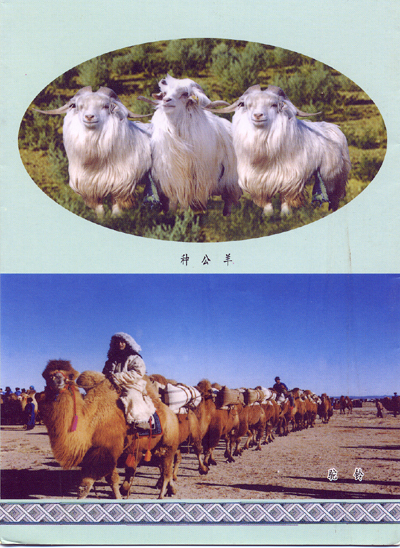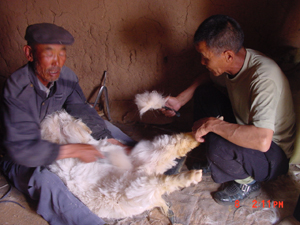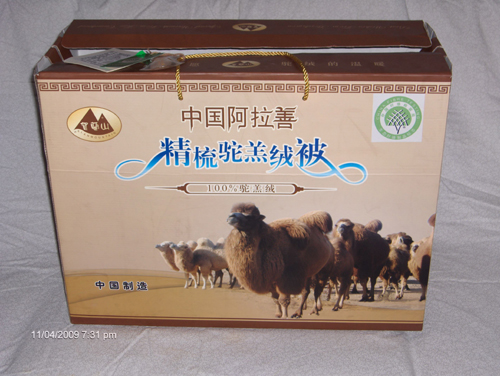ECOLOGIA's "Sustainable Fibers" Program

The goal of our program is to create a supply chain for cashmere and camel fiber that will allow Inner Mongolian herders to produce fiber in a manner that is environmentally, economically, and socially sustainable. It should revitalize the already degraded landscape, as well as assist in the preservation of traditional Mongolian social and cultural practices.
A sustainable and fair trade supply chain for camel and cashmere fiber products will support the growth of socially responsible and environmentally sound practices locally and globally.
The supply chain links each of these members:
- cooperatives of goat and camel herders in Inner Mongolia, China - Cooperative members restore the desertified ecosystem by reducing the numbers of goats they raise, and byincreasing the numbers of camels. While cashmere goats' sharp hooves can destroy fragile plant life when herd numbers are too large, camels' broad flat hooves tred gently and are much more 'desert friendly'.
- purchasers, processing factories and mills, and fiber wholesalers - When purchasers pay herders a fair price, they enable herders to become economically viable while decreasing their goat herd sizes. Companies that hire skilled workers and provide living wages and good working conditions are strong long-term partners.
- brand-name buyers and retailers - They are often motivated by a need to demonstrate their good business and purchasing practices to their customers. Marketing high quality sustainable camel and cashmere products can distinguish them from competitors.
- consumers - Globally aware consumers are proud of their contribution to support herding families and cooperatives, and to contribute to their quest for long-term ecological survival.
BACKGROUND AND GOALS
In the western Alashan region of Inner Mongolia, in north central China, goat and camel herders live in a sparsely populated desert. Massive dust storms, related to desertification caused by over-grazing of cashmere goats, can blot out the sun and bury roads and villages. The herders we work with live, work and conduct business in amazing physical and social isolation. Economically, they are at the bottom of the global supply chain for cashmere, a luxury fiber that has, during the past decade, been turned into a mass commodity and marketed at hyper-competitive prices across the globe.
CASHMERE: Problems of Overproduction and Overgrazing
For the middle class in developed countries, wearing affordable cashmere now provides access to comfort and status once reserved for the elite. For Inner Mongolian herders, the global supply chain that makes this possible has been a mixed blessing. In the 1990s, as the demand for cashmere went up, the soft fiber was viewed as "spun gold". The expansion of goat herds, driven by high global demand for cheap cashmere, has caused massive overproduction and overgrazing. These goat herds are damaging the fragile desert ecosystem upon which their industry, livelihood and culture depend. The Chicago Tribune's investigative report by Evan Osnos, "Your cheap sweater's real cost" provides vivid stories of the seriousness of the current situation.
Dust storms that darken Beijing's skies and close airports in Korea are becoming more common. The price of cashmere is fluctuating and the profit margin vanishing as herders become ever more reliant on corn (maize) fodder, the cost of which is subject to global demand. Herders are now forming cooperatives, seeking a sustainable path to economic, environmental and community survival.
CAMEL FIBER: An Ecologically Friendly Alternative to Cashmere
Camel herd numbers have dropped over the past several decades, in response to the economic pressures in favor of cashmere. When herders are desperate for money - which is an all-too-common occurrance when they are caught in the global pressures for "ever lower" prices for their products - they sell camels, or slaughter them for food. If the demand for, and price of, camel fiber can become more predictable and fairer to the herders, they will be able to expand their camel herds. This is important because the desert region can support large numbers of camels, which are much more eco-friendly than goats. Camels' grazing patterns complement those of goats, and contribute to the ecological balance of the region. An increasingly important part of ECOLOGIA's "sustainable fibers" program is promoting the use and superior ecological contribution of camel raising, and camel fiber production.
SUMMARY
ECOLOGIA and an international team of animal husbandry, desert ecosystem and business experts are calculating the sustainable cost threshold for cashmere and for camel fiber. We are working to raise a "sustainability premium" from purchasers of camel fiber and cashmere, to transfer to the herders. We are also working to encourage herders' cooperatives as a self-governing and empowering approach to land and herd management. Our sustainable supply chain and marketing program for camel and cashmere supports herders' environmental restoration activities and responsible grazing practices, including goat herd size reduction and more reliance on camels.

SUPPORTERS
-
- The Ford Foundation (2008 - 2011)
- Keidanren Nature Conservation Fund, Japan (2009-2010)
- Eileen Fisher Community Partnership Grant (2011)
- Heavens-Geneve, Switzerland (2011) as part of their environmental commitments for obtaining certified status as a Carbon Neutral company
FOR MORE INFORMATION
Photo Essay: Working toward a sustainable camel and cashmere fiber supply chain
Analysis by Randy Kritkausky - Caravans of Hope: Camels, Tea and Entrepreneurs on the Silk Road in the 21st Century
ECOLOGIA Works on ISO 26000: ECOLOGIA is using ISO 26000, the new global guidance standard for social responsibility, to inform our work with partners along the supply chain, and to attest to their efforts to address environmental, social and economic issues of long-term sustainability.
SURE- SUpport for Responsible Enterprises -
An ECOLOGIA Sustainability Initiative. A fiber manufacturer in Bayanhut, Alashan, is making and selling value-added fine quality camel fiber products, such as "camel fiber quilts", to an increasingly sophisticated Chinese market.

|
